
Shibuya is known as Tokyo’s premier hub for Japan’s youth, fashion, and subcultures of all kinds. In the center of it towers the large Shibuya Station and its famous Faithful Dog Hachiko, a beloved statue acting as a meeting place for friends, lovers, and more.
With four of Tokyo’s major railway companies serving the station, Shibuya is one of Tokyo’s main gateways to surrounding areas and other neighborhoods of the mega-metropolis. With platforms both above ground and underground, as well as dozens of exits and passages, the station may seem like an unbeatable maze to first-time visitors. We compiled a complete guide to Shibuya Station, its trains, exits, and structure to save you from getting lost!
7 Key Points of Shibuya Station to Remember
1) The four companies serving Shibuya Station: JR East, Keio Electric Railway, Tokyu Electric Railway, and Tokyo Metro
Four of Tokyo’s major railway companies serve the large Shibuya Station. JR East doesn’t only operate the Yamanote Line, a prime choice for sightseers, but also the Saikyo Line, Shonan Shinjuku Line, and the Narita Express to the airport. Keio Electric Railway operates the Inokashira Line, while Tokyu Electric Railway’s Tokyu Den-en-toshi Line and Tokyu Toyoko Line serve Tokyo’s south and the neighboring Kanagawa Prefecture. Tokyo Ginza Line, Hanzomon Line, and Fukutoshin Line are operated by Tokyo Metro.


2) The JR station part has four major exits: Hachiko Exit, Miyamasuzaka Exit, West Exit, and East Exit
Shibuya Station stretches rather long towards north and south. The main exits are the Hachiko Exit in the northwest, the Miyamasuzaka Exit in the northeast, the East Exit in the southeast, and the West Exit in the southwest. The famous Shibuya Crossing, as well as the popular shopping center SHIBUYA109 are right in front of the Hachiko Exit. About 300 meters away from the center of Shibuya Station lies the Shin-Minamiguchi Exit, on the southern tip of the station that is home to the platforms of the Saikyo Line and Shonan Shinjuku Line.

3) Tokyu and Tokyo Metro share both platforms and ticket gates
Tokyu Electric Railway’s Den-en-toshi Line and Tokyo Metro’s Hanzomon Line share platforms 1 and 2 on the 3rd basement floor for arrival and departure. The 5th basement floor’s platforms 3 and 4 serve both Tokyu’s Toyoko Line and Tokyo Metro’s Fukutoshin Line. These four lines are connected by passages within the ticket gates, making transfer easy and comfortable.

4) Only Tokyo Metro’s Ginza Line has dedicated platforms and ticket gates
Of the three Tokyo Metro lines that serve Shibuya Station, only Ginza Line has dedicated platforms and ticket gates. Ginza Line’s platforms are set up to cross JR’s platforms, found on the 3rd floor directly above the JR lines, along with its ticket gates. If you transfer from the JR Lines, taking the central ticket gates or Tamagawa ticket gates is most convenient.

5) Keio Electric Railway and JR Shibuya Station are directly connected
Keio’s part of the station, where Keio Inokashira Line arrives and departs, is located on the west side of JR Shibuya Station. Its upper part is connected to the shopping complex Shibuya Mark City. The two stations are also connected via a passage on the second floor. It takes about 5 minutes to transfer if you exit via JR’s Tamagawa ticket gates.

6) The underground passage “Shibuya Chikamichi” extends over both the 1st and 2nd basement floor
Shibuya Chikamichi is an underground passage that leads from Shibuya Station towards the downtown area. It is connected to the ticket gates of Tokyu Electric Railway and Tokyo Metro, as well as JR Shibuya Station, Tokyu Department Store, Shibuya Mark City, SHIBUYA109, and Shibuya Hikarie. Especially on rainy days, this passage is incredibly convenient.
Shibuya Chikamichi itself extends over the 1st and 2nd basement floor. Tokyu Electic Railway and Tokyo Metro’s Dogenzaka ticket gates, the Hachiko ticket gates, the Miyamasuzaka central ticket gates, and the Miyamasuzaka east ticket gates can all be found on the 2nd basement floor.
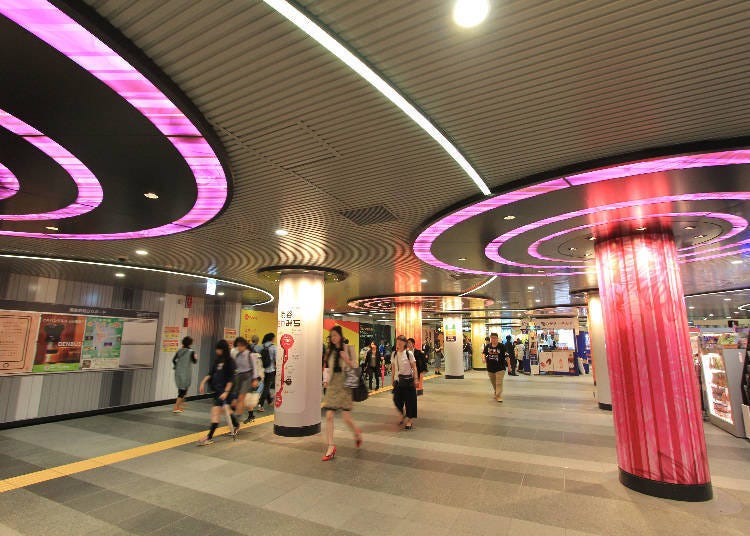
7) Shibuya Station’s east side is under construction until 2026
The east side of Shibuya Station is undergoing large-scale construction works that are scheduled to go on until 2026. This primarily affects the area around Miyamasuzaka Exit and East Exit and a temporary passage is set up. This area can be rather confusing, so make sure to follow any signs as closely as possible.

The Lines of Shibuya Station

Shibuya Station acts as an important gateway to Tokyo’s other areas and surroundings. JR’s Yamanote Line, for example, circles the central Tokyo area, while the Tokyu Toyoko Line takes you straight to Yokohama without the need for transfer. The Keio Inokashira Line goes to Kichijoji and Shimokitazawa, trendy yet relaxed areas in Tokyo’s west, and Tokyo Metro’s Hanzomon Line is useful if you want to see Tokyo Skytree. Shibuya Station is a great hub for both sightseeing and traveling.

Exit Guide - What’s Around Shibuya Station’s East and West Exit?
・The West Side:
Hachiko Statue, Shibuya Crossing, Shibuya Center Street, SHIBUYA109, Tokyu Department Store, Tokyu Hands, Shibuya Mark City, Shibuya Loft, Spain-zaka, Bunkamura, West Exit Bus Terminal, etc.

Exit the station via Hachiko Exit and the famous Shibuya Crossing sprawls right in front of you. If you continue straight, you’ll find yourself at Shibuya Center Street and SHIBUYA109. If you take the West Exit, you’ll get to the West Exit Bus Terminal.

・The East Side:
Shibuya Hikarie, East Exit Bus Stop, Shibuya TOEI, Bic Camera Shibuya East Exit, Shibuya Tokyu Inn, Miyashita Park, Tamatsukuri Inari Shrine, Aoyama Gakuin University Campus, etc.

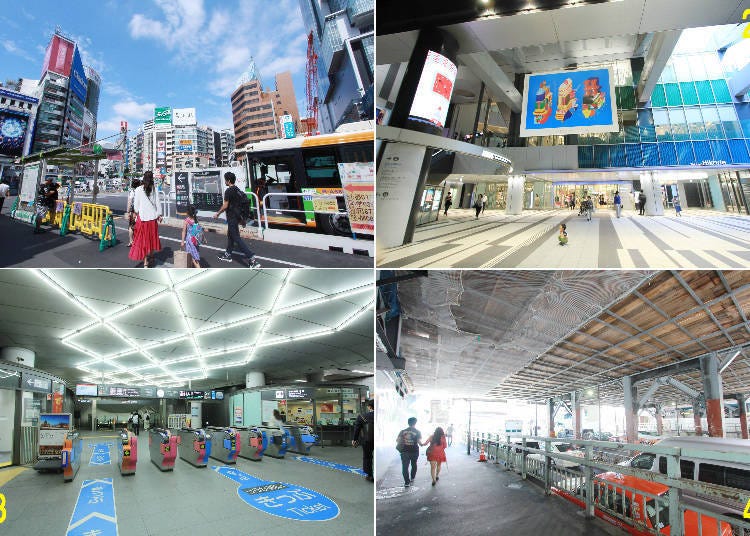
As of August 2017, large-scale construction works are underway at Shibuya Station’s east side. The East Exit Bus Terminal has moved to the “East Exit Bus Stop” at the plaza in front of Miyamasuzaka Exit.
The West Exit Area: the Home of SHIBUYA109 and Hachiko
The main exits of Shibuya Station’s west side are Hachiko Exit in the north and West Exit in the south. Only JR’s Hachiko ticket gates are directly connected to Hachiko Exit. There are actually two Hachiko ticket gates, adjacent to each other – they’re the same but called “Hachiko Entrance” and “Hachiko Exit” in English.
Reaching the southern ticket gates from West Exit is fairly easy to understand, but you can also take the central ticket gates and descend the stairs. Here are the directions for each exit, starting at JR’s Yamanote Line to Shinagawa / Tokyo (outbound) on platform 2.
●Towards Hachiko Exit
1) Get off the train and turn to the left (north)
2) Go down the stairs at the northern end of the platform
3) Turn left after descending the stairs and you will find Hachiko Exit to your right.
4) Leave the station via Hachiko ticket gates and you will stand right in front of the square home to Hachiko Statue.

●Towards West Exit
1) Turn south and take either the second stairs or the southernmost stairs.
2) After descending the stairs, pass through the ticket gates at the plaza in front of you.
3) Follow the passage to the left.
4) Reach the West Exit (West Exit Bus Terminal) at the end of the passage.

The East Exit Area: Miyamasuzaka and Shibuya Hikarie
Shibuya Station’s east side has two main exits: Miyamasuzaka Exit in the north and East exit in the south. As of 2017, however, the whole east side area is undergoing large-scale construction works, so you will have to access Shibuya Hikarie, as well as Tokyu and Tokyo Metro lines via a temporary passage along the construction site.
●Towards Miyamasuzaka Exit
1) Descend the northernmost stairs on platform 2.
2) Turn to the left right after the stairs and leave via the Hachiko Entrance ticket gates on your left.
3) Proceed to the left and continue through the passage.
4) You’ll arrive at Miyamasuzaka Exit. Continue straight and the East Exit bus stop is to your right.

●Towards East Exit
1) Turn south and take either the second stairs or the southernmost stairs.
2) After descending the stairs, exit the south ticket gates and head towards the right.
3) Continue along the passage, along the construction site.
4) Transfer to Tokyu Electric Railway and Tokyo Metro, as well as access to Shibuya Hikarie is possible via the descending escalator on the right side.
※If you continue straight ahead, you’ll leave the station building (East Exit bus station, taxi stand, and transfer to the Ginza Line can be found outside).

●Towards East Exit
1. Ascend one of the two stairs in the center of platform 2.
2. Follow the signs saying “Shin-Minami ticket gate” (新南改札)
3. Keep following the signs and continue along the passage, in the opposite direction of the central ticket gates.
4. Go straight towards the wide passage (it is marked by a moving walkway in the center)
5. Take the escalator in front of the southern end of the passage, down to platform 3 and 4.
6. Go straight over platform 3 and 4 (Saikyo Line, Shonan Shinjuku Line, Narita Express).
7. Find the drink stand HONEY’S BAR at the southern end of the platform and take the escalator in front of it. Go up.
8. Pass through he Shin-Minami ticket gates and continue down the stairs and continue on outside via the Shin-Minami Exit.


Transfers at Shibuya Station from JR’s Yamanote Line
JR East’s Yamanote Line is one of the most-used lines for both sightseeing and getting around, which is why we will go over the transfers to Keio Electric Railway, Tokyu Electric Railway, and Tokyo Metro.
●JR East Yamanote Line → Keio Inokashira Line
1. Go up one of the two stairs in the center of platform 2.
2. Descend to platform 1 via the stairs next to the central ticket gates.
3. Make a U-turn and continue along the platform in the opposite direction.
4. Find the Tamagawa ticket gates on the left side of platform 1 and pass through them.
5. Continue diagonally to the right.
6. Go straight through the passage inside Tokyu Department Store (Shibuya Station, Toyoko Branch).
7. Go up the stairs and continue straight through a wide passage, marked by a large mural by Taro Okamoto.
8. You’ll arrive at the Central Exit of the Keio Shibuya Station.

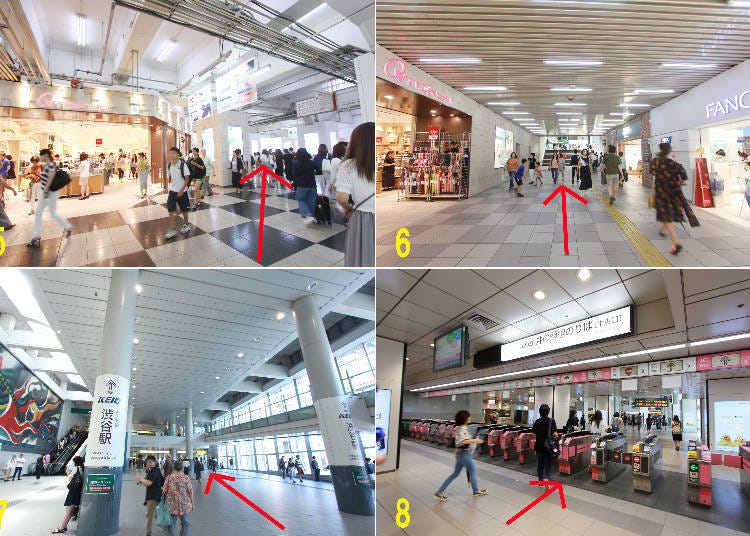
●JR East Yamanote Line → Tokyu Den-en-toshi Line and Tokyo Metro Hanzomon Line
1. Go down the stairs at the northern end of platform 2.
2. Turn left at the end of the stairs and pass the Hachiko Entrance ticket gates.
3. Turn right immediately and go down the stairs.
4. Turn right again after the stairs.
5. Go down the stairs that have signs with Tokyu Toyoko Line, Fukutoshin Line, Tokyu Den-en-toshi Line, and Hanzomon Line.
6. Turn left after the stairs and go straight through Shibuya Chikamichi.
7. Turn right to make a U-turn at the ticket vending machines.
8. You’ll arrive at the Hachiko ticket gates of Tokyu and Tokyo Metro.

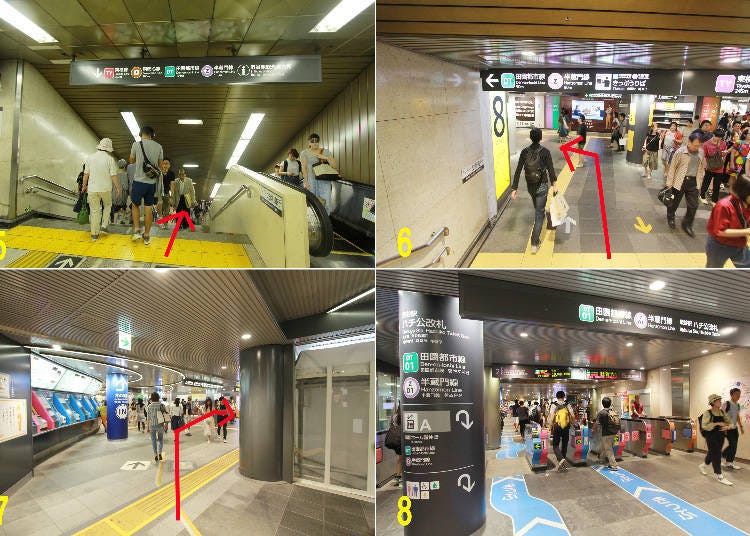
●JR East Yamanote Line → Tokyu Toyoko Line and Tokyo Metro Fukutoshin Line
1. Go down the stairs at the northern end of platform 2.
2. Turn left at the end of the stairs and pass the Hachiko Entrance ticket gates.
3. Turn right immediately and go down the stairs.
4. Turn right again after the stairs.
5. Go down the stairs that have signs with Tokyu Toyoko Line, Fukutoshin Line, Tokyu Den-en-toshi Line, and Hanzomon Line.
6. Turn right after the stairs and go straight through Shibuya Chikamichi.
7. Pass by the Shibuya Station Tourist Office and coin lockers.
8. You’ll arrive at the Miyamasuzaka ticket gate of Tokyu and Tokyo Metro.


●JR East Yamanote Line → Tokyo Metro Ginza Line
1. Go down the stairs next to the central ticket gates to platform 1.
2. Exit via the Tamagawa ticket gate on platform 1,
3. Proceed to the right and go up the stairs, next to a shop called “index pres.”
4. After going up the stairs, you’ll find a ticket office on the right and Ginza Line’s Hachiko Intersection ticket gates on the left.
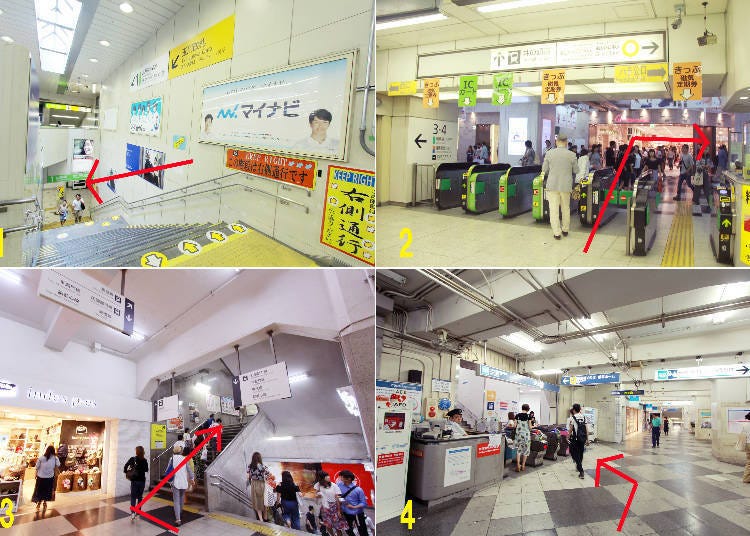
Traveling from Shibuya Station! Towards Yokohama and Mitaka
・ Yokohama

Yokohama is the prefectural capital of Kanagawa and a plethora of sightseeing spots. The most convenient way to get to Yokohama from Shibuya Station is via the Tokyu Toyoko Line – the express train takes you there in about 30 minutes, the limited express in only about 26. From Yokohama Station, the popular spots of Minato Mirai and Motomachi-Chukagai (Chinatown) are easily accessible via Yokohama Minatomirai Railway’s Minatomirai Line. There are also certain express and limited express trains that directly connect Shibuya Station to Minatomirai Station and Motomachi-Chukagai Station, without the need to transfer.
The platform of Tokyu’s Toyoko Line is on the 5th basement floor of Shibuya Station. For transfer from JR’s Yamanote Line, please see “JR East Yamanote Line → Tokyu Toyoko Line and Tokyo Metro Fukutoshin Line.”

Kichijoji is a neighborhood located in the city of Musashino, in Tokyo’s west. It’s a very popular area along JR’s Chuo Line, with the lush Inokashira Park, the Ghibli Museum, and numerous atmospheric shops and restaurants to explore. Kichijoji Station is served by Keio’s Inokashira Line which will take you there in 17 minutes per express train, without the need to transfer. The Keio part of Shibuya Station is located on the west side, marked by the commercial facility Shibuya Mark City. It’s connected to JR Shibuya Station via a convenient passage. For transfer from JR’s Yamanote Line, please see “JR East Yamanote Line → Keio Inokashira Line.”
*Prices and options mentioned are subject to change.
*Unless stated otherwise, all prices include tax.
Popular Tours & Activitiess
Recommended places for you
-

The Tokyo Station Marunouchi Building
Landmarks
Tokyo Station
-

Shinjuku Gyoen National Garden
Gardens
Shinjuku
-

TOKYO SKYTREE®
Landmarks
Ryogoku / TOKYO SKYTREE(R)
-

Ameyoko Shopping Street
Old Towns (Shitamachi)
Ueno
-

The Imperial Palace
Other Architecture
Tokyo Station
-

Ueno Zoo (Ueno Zoological Gardens)
Zoos, Aquariums & Botanical Gardens
Ueno
-
Ad

Just 2 Hours from Tokyo! Enjoy Ibaraki’s Breathtaking Ocean Views, Flowers & Autumn Leaves on Private Tours
-

Fine Dining on Rails? Japan Announces Stunning NEW 'Laview' Restaurant Train
-

(12% OFF KKday Coupon) Mt. Fuji Autumn Leaves, Powder Snow & More! 15 Best Tours to Experience Japan in Fall & Winter
-
Ad

Walk in the Footsteps of Believers: A 4-Day Pilgrimage Across Goto Islands, Nagasaki Prefecture
by: Yohei Kato
-

2025 Japan Autumn Color Report: Northeastern Japan Nearing Peak
by: Timothy Sullivan
-

See Asakusa and Tokyo Skytree® in a New Light at the "Také Akari" Festival (Winter 2025-2026)
by: Guest Contributor
Inspiration for Accommodations
-

Enjoy Mt. Fuji from the Comfort of Your Room! Recommended Ryokan with Mt. Fuji View
-

Stay Near the Cherry Blossoms! Hotels for Cherry Blossom Viewing in Tokyo
-

Family-Friendly Hotels with Free Shuttle to Disneyland: Convenient Access for a Magical Stay
-

Top Ranked Hakone Hotels with Mt. Fuji View: Enjoy Stunning Scenery from Your Private Space
-

Convenient Tokyo Hotels with Airport Shuttle: Ideal for Families and Heavy Luggage
-

Stunning Tokyo Tower View Hotels: Enjoy Spectacular Scenery from Your Private Space
-

Convenient Asakusa Hotels with Kitchens: Ideal for Extended Family Visits
-

Experience Luxury: Hakone's 10 Best Five-Star Accommodations
-

Enjoy Mt. Fuji Autumn Leaves! Top Hotels Near the Popular Autumn Leaves Corridor
-

Experience Hakone Fall Foliage from Your Room with Stunning Views
-

Secrets to Shopping in Japan: Guide to Annual Sales in Japan & Where to Shop
by: Miyu Shimada
-

4 Best Tokyo Festivals in March: Fun Ways to Greet Spring
-

10 Best Spots in Tokyo for Stunning Photos of Mount Fuji
-

3 Spots to Fully Enjoy Ikebukuro's Amusement Scene
-

Top 3 Spots to Get Your Christmas Chicken in Tokyo 2021
by: Kei Suzuki
-

Tokyo Station Top 10 Sweets Ranking!
- #best ramen tokyo
- #what to buy in ameyoko
- #what to bring to japan
- #new years in tokyo
- #best izakaya shinjuku
- #things to do tokyo
- #japanese nail trends
- #what to do in odaiba
- #onsen tattoo friendly tokyo
- #daiso
- #best sushi ginza
- #japanese convenience store snacks
- #best yakiniku shibuya
- #japanese fashion culture
- #best japanese soft drinks












